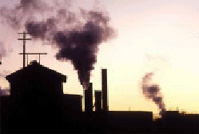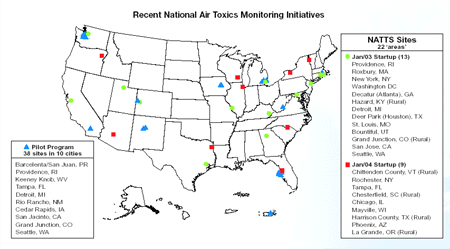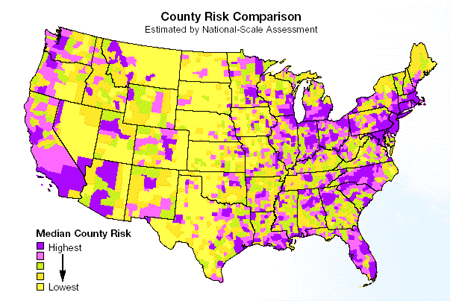Nature and Sources of the Problem
 Toxic air pollutants, or air toxics, are those pollutants that cause or
may cause cancer or other serious health effects, such as reproductive effects
or birth defects. Air toxics may also cause adverse environmental and ecological
effects. Examples of toxic air pollutants include benzene, found in gasoline;
perchloroethylene, emitted from some dry cleaning facilities; and methylene
chloride, used as a solvent by a number of industries. Most air toxics originate
from man-made sources, including mobile sources (e.g., cars, trucks, construction
equipment) and stationary sources (e.g., factories, refineries, power plants),
as well as indoor sources (e.g., some building materials and cleaning solvents).
Some air toxics are also released from natural sources such as volcanic
eruptions and forest fires.The Clean Air Act identifies 188 air toxics from
industrial sources. EPA has identified 21 pollutants as mobile source air
toxics, including diesel particulate matter and diesel exhaust organic gases.
In addition, EPA has listed 33 urban hazardous air pollutants that pose
the greatest threats to public health in urban areas.
Toxic air pollutants, or air toxics, are those pollutants that cause or
may cause cancer or other serious health effects, such as reproductive effects
or birth defects. Air toxics may also cause adverse environmental and ecological
effects. Examples of toxic air pollutants include benzene, found in gasoline;
perchloroethylene, emitted from some dry cleaning facilities; and methylene
chloride, used as a solvent by a number of industries. Most air toxics originate
from man-made sources, including mobile sources (e.g., cars, trucks, construction
equipment) and stationary sources (e.g., factories, refineries, power plants),
as well as indoor sources (e.g., some building materials and cleaning solvents).
Some air toxics are also released from natural sources such as volcanic
eruptions and forest fires.The Clean Air Act identifies 188 air toxics from
industrial sources. EPA has identified 21 pollutants as mobile source air
toxics, including diesel particulate matter and diesel exhaust organic gases.
In addition, EPA has listed 33 urban hazardous air pollutants that pose
the greatest threats to public health in urban areas.
Health and Environmental Effects
People exposed to toxic air pollutants at sufficient concentrations may
experience various health effects, including cancer and damage to the immune
system, as well as neurological, reproductive (e.g., reduced fertility),
developmental, respiratory, and other health problems.
In addition to exposure from breathing air toxics, risks also are associated
with the deposition of toxic pollutants onto soils or surface waters, where
they are taken up by plants and ingested by animals and eventually magnified
up through the food chain. Like humans, animals may experience health problems
due to air toxics exposure.
Trends in Toxic Air Pollutants
EPA and states do not maintain an extensive nationwide monitoring network
for air toxics as they do for many of the other pollutants discussed in
this report. Although EPA, states, tribes, and local air regulatory agencies
collect monitoring data for a number of toxic air pollutants, both the chemicals
monitored and the geographic coverage of the monitors vary from state to
state. Currently, there are about 300 air toxics monitoring sites in operation.The
available monitoring data help air pollution control agencies track toxic
air pollutant levels in various locations around the country. EPA is working
with its regulatory partners to build on the existing monitoring sites to
create a national monitoring network for a number of toxic air pollutants.The
goal is to ensure that those compounds that pose the greatest risk are measured.
EPA initiated a 12-month pilot monitoring project in 2001 in four urban
areas and six small city/rural areas (see map below).The pilot program was
developed to help answer several important national network design questions
(e.g., sampling and analysis precision, sources of variability,minimal detection
levels). A National Air Toxic Trend Site (NATTS) network was launched in
early 2003.The central goal of the NATTS network is to detect trends in
high-risk air toxics such as benzene, formaldehyde, 1,3-butadiene, acrolein,
and chromium. By early 2004, 22 NATT sites (16 urban and 6 rural) will be
operating (see map). For the latest information on national air toxics monitoring,
see www.epa.gov/ttn/amtic/airtxfil.html.
EPA also compiles an air toxics inventory as part of the National Emissions
Inventory (NEI, formerly the National Toxics Inventory) to estimate and
track national emissions trends for the 188 toxic air pollutants regulated
under the Clean Air Act. In the NEI, EPA divides emissions into four types
of sectors: (1) major (large industrial) sources; (2) area and other sources,
which include smaller industrial sources like small dry cleaners and gasoline
stations, as well as natural sources like wildfires; (3) onroad mobile
sources, including highway vehicles; and (4) nonroad mobile sources like
aircraft, locomotives, and construction equipment.
 |
 |
As shown in this pie chart, based on 1996 estimates (the most recent year
of available data), the emissions of toxic air pollutants are relatively
equally divided between the four types of sources. However, this distribution
varies from city to city.
Based on the data in the NEI, estimates of nationwide air toxics emissions
decreased by approximately 24 percent between baseline (1990-1993) and
1996.Thirty-three of these air toxics that pose the greatest threat to
public health in urban areas have similarly decreased 31 percent.Although
changes in how EPA compiled the national inventory over time may account
for some differences, EPA and state regulations, as well as voluntary reductions
by industry, have clearly achieved large reductions in overall air toxic
emissions.
Trends for individual air toxics vary from pollutant to pollutant. Benzene,
which is the most widely monitored toxic air pollutant, is emitted from
cars, trucks, oil refineries, and chemical processes.The graph below shows
trends for benzene at 95 urban monitoring sites around the country.These
urban areas generally have higher levels of benzene than other areas of
the country. Measurements taken at these sites show, on average, a 47 percent
drop in benzene levels from 1994 to 2000. During this period, EPA phased
in new (so-called tier 1) car emission standards; required many cities
to begin using cleaner burning gasoline; and set standards that required
significant reductions in benzene and other pollutants emitted from oil
refineries and chemical processes. EPA estimates that benzene emissions
from all sources dropped 20 percent nationwide from 1990 to 1996. In the
2001 toxics pilot monitoring project, city averages of benzene ranged from
about 0.9 to 2.5 µg/m3.
Risk Assessment
EPA has developed a National-Scale Air Toxics Assessment, which is a nationwide
analysis of air toxics. It uses computer modeling of the 1996 NEI air toxics
data as the basis for developing health risk estimates for 33 toxic air
pollutants (a subset of the Clean Air Act’s list of 188 air toxics plus
diesel PM).The national-scale assessment is intended to provide state, local,
and tribal agencies and others with a better understanding of the risks
from inhalation exposure to toxic air pollutants from outdoor sources. It
will help EPA and states prioritize data and research needs to better assess
risk in the future and will provide a baseline to help measure future trends
in estimated health risks.The next national-scale analysis will focus on
1999 data and is expected to be released by the end of 2003.
The map on page 23 shows a pattern of the distribution of relative cancer
risk across the continental United States as estimated by the national-scale
assessment.The highest ranking 20 percent of counties in terms of risk
(622 counties) contain almost three-fourths of the U.S. population.Three
air toxics (chromium, benzene, and formaldehyde) appear to pose the greatest
nationwide carcinogenic risk.This map does not include the potential risk
from diesel exhaust emissions.This is because existing health data are
not sufficient to develop a numerical estimate of cancer risk for this
pollutant. However, exposure to diesel exhaust is widespread, and EPA has
concluded that diesel exhaust is a likely human carcinogen and ranks with
the other substances that the national-scale assessment suggests pose the
greatest relative risk. One air toxic, acrolein, is estimated to pose the
highest potential nationwide risk for significant chronic adverse effects
other than cancer. For more information, visit www.epa.gov/ttn/atw/nata.
This technical assessment represents an important step toward characterizing
air toxics nationwide. It is designed to help identify general patterns
in air toxics exposure and risk across the country and is not recommended
as a tool to characterize or compare risk at local levels (e.g., to compare
risks from one part of a city to another). More localized assessments,
including monitoring and modeling, are under way to help characterize local-level
risk.
Programs to Reduce Air Toxics
Since 1990, EPA’s technology-based emission standards for industrial and
combustion sources (e.g., chemical plants, oil refineries, dry cleaners,
and municipal waste combustors) have proven extremely successful in reducing
emissions of air toxics. Once fully implemented, these standards will cut
annual emissions of toxic air pollutants by nearly 1.5 million tons from
1990 levels. Of this total reduction, dioxin emissions from municipal waste
combustors and municipal waste incinerator units will have been reduced
by approximately 99 percent and mercury emissions by 95 percent. Additional
reductions are expected by 2005. EPA has also put into place important controls
for motor vehicles and their fuels, including introduction of reformulated
gasoline and low sulfur diesel fuel, and is taking additional steps to reduce
air toxics from vehicles. Furthermore, air toxics emissions will further
decline as the motor vehicle fleet turns over, with newer vehicles replacing
older higher-emitting vehicles. By the year 2020, these requirements are
expected to reduce emissions of a number of air toxics (benzene, formaldehyde,
acetaldehyde, and 1,3-butadiene) from highway motor vehicles by about 75
percent and diesel PM by over 90 percent from 1990 levels.

In addition to national regulatory efforts, EPA’s program includes work
with communities on comprehensive local assessments, as well as federal
and regional activities associated with protecting waterbodies from air
toxics deposition (e.g., the Great Waters program,  which
includes the Great Lakes, Lake Champlain, Chesapeake Bay, and many coastal
estuaries) and EPA initiatives concerning mercury and other persistent
and bioaccumulative toxics. For indoor air toxics, EPA’s program has relied
on education and outreach to achieve reductions. Information about indoor
air activities is available at www.epa.gov/iaq/.
For more information about EPA’s air toxics program, visit the Agency’s
Web site at www.epa.gov/ttn/atw. which
includes the Great Lakes, Lake Champlain, Chesapeake Bay, and many coastal
estuaries) and EPA initiatives concerning mercury and other persistent
and bioaccumulative toxics. For indoor air toxics, EPA’s program has relied
on education and outreach to achieve reductions. Information about indoor
air activities is available at www.epa.gov/iaq/.
For more information about EPA’s air toxics program, visit the Agency’s
Web site at www.epa.gov/ttn/atw.
|

